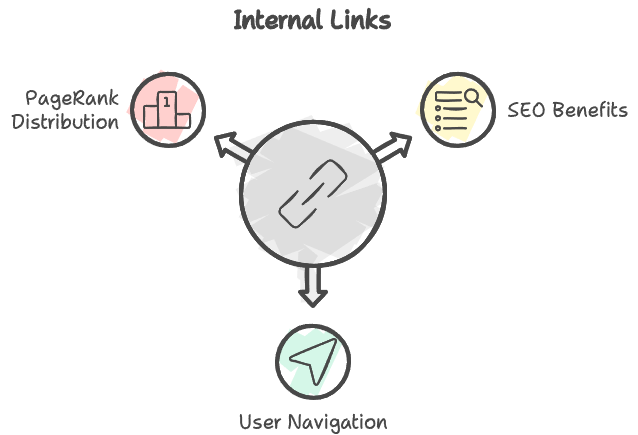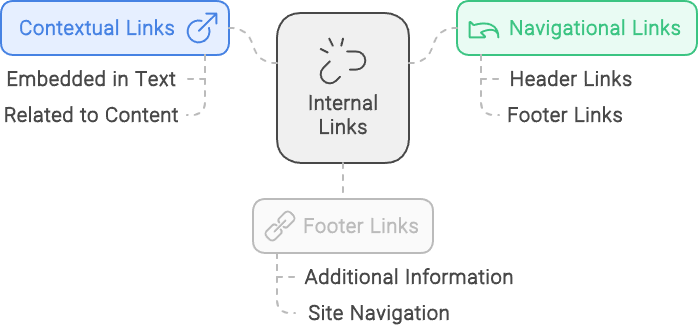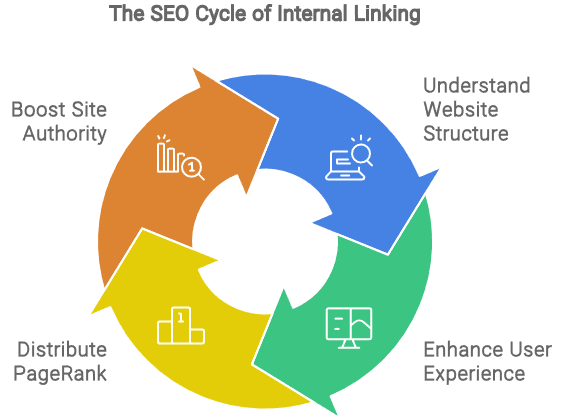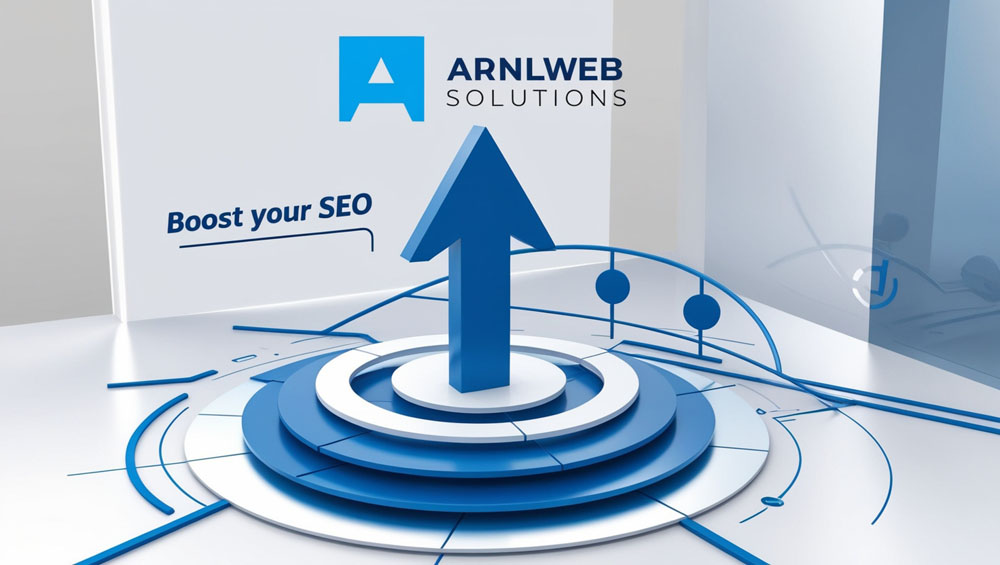Internal Linking Fundamentals
Understanding internal linking is essential for effective on-page SEO. Internal links not only enhance navigation for users but also play a vital role in how search engines perceive and rank a website.
Importance of Internal Links

Internal links are crucial for SEO as they help search engines understand a site’s structure, crawl and index pages, and demonstrate contextual relationships between pages (SEMrush). They enhance user experience by aiding visitors in navigating between relevant pages, keeping them engaged, and increasing the likelihood of completing desired actions, such as making a purchase or filling out a form.
The following table summarizes the key benefits of internal links:
| Benefit | Description |
|---|---|
| Site Structure | Helps define the hierarchy and relationships between pages |
| User Navigation | Improves user experience by facilitating easy access to content |
| Crawl Efficiency | Aids search engine crawlers in discovering new and updated content |
| Contextual Relevance | Demonstrates how pages relate to each other, improving SEO |
Types of Internal Links

There are various types of internal links that one can implement to optimize a website effectively. Each type serves a distinct purpose in enhancing user experience and improving SEO.
| Type of Internal Link | Description |
|---|---|
| Navigation Links | Found in menus and footers, guiding users to important sections of the site |
| Contextual Links | Embedded within content, linking to related articles or pages, enhancing relevance |
| Footer Links | Links located in the footer area, often directing to important but less frequently accessed pages |
| Breadcrumb Links | Help users track their location on a site and navigate back to previous pages |
Utilizing a combination of these internal linking strategies can significantly contribute to optimizing individual web pages for higher search engine rankings and relevant traffic (ARNL Web Solutions). By creating a network of connections between related content, users can easily find what they need beyond the initial post they encounter. This approach not only enhances user experience but also helps eliminate broken links and redirect loops, ultimately building site authority. For more comprehensive strategies, refer to our on-page SEO checklist and on-page SEO techniques.
SEO Benefits of Internal Linking
Internal linking strategies play a crucial role in enhancing the overall effectiveness of a website’s SEO. They not only improve site structure but also boost search engine rankings, making them an essential component of on-page SEO.

Enhancing Site Structure
Internal links are vital for creating a clear and organized site structure. They help search engines understand how different pages relate to one another. By demonstrating contextual relationships between pages, internal links assist search engines in crawling and indexing content effectively (SEMrush).
| Benefit | Description |
|---|---|
| Improved Navigation | Internal links guide users to relevant content, enhancing their experience. |
| Increased Engagement | By linking related articles or products, visitors are likely to spend more time on the site. |
| Clear Hierarchy | A well-structured internal linking strategy allows for a logical flow of information, making it easier for both users and search engines to navigate. |
Internal links also enhance user experience by helping visitors navigate between relevant pages on a site, keeping them engaged and increasing the likelihood of completing desired actions, such as making a purchase or filling out a form (SEMrush).
Boosting Search Engine Rankings
Internal linking not only improves user experience but also positively impacts search engine rankings. By passing authority (PageRank) to other pages on a site, internal links can significantly aid in improving rankings. Pages with many external links pointing to them can pass authority to connected pages through internal links, creating a beneficial cycle of link equity.
| Impact | Description |
|---|---|
| Authority Distribution | Internal links help distribute authority across pages, enhancing the overall SEO of the site. |
| Enhanced Rankings | Strong internal linking can lead to improved positions in search engine results pages (SERPs). |
| Conversion Guidance | Internal links drive users toward conversion by guiding them through the buyer’s journey, leading them from initial awareness to becoming leads and customers (seoClarity). |
By enhancing site structure and boosting search engine rankings, effective internal linking strategies can transform isolated web pages into a cohesive content infrastructure, resulting in significantly improved SEO (seoClarity). For a comprehensive overview, refer to our on-page seo checklist and explore other on-page seo techniques that complement internal linking for optimal results.
Strategies for Effective Internal Linking
Implementing effective internal linking strategies can significantly enhance a website’s SEO performance. This section covers how to create a linking strategy and the importance of monitoring and optimizing links.
Creating a Linking Strategy
A well-planned linking strategy is essential for maximizing the benefits of internal links. This approach involves several key steps:
- Identify Key Pages: Determine which pages on the website hold the most importance, such as high-converting pages or those that attract significant traffic. This will help focus linking efforts where they can have the most impact.
- Use Descriptive Anchor Text: The text used for links should be relevant to the content of the destination page. Descriptive anchor text helps both users and search engines understand what to expect when clicking the link.
- Establish a Hierarchical Structure: Organize content into categories and subcategories. This structure makes it easier to create internal links that guide users through related topics.
- Link to New Content: Whenever new content is published, ensure that it is linked to existing relevant pages. This not only helps with SEO but keeps the site interconnected and user-friendly.
- Limit the Number of Links: While internal linking is beneficial, too many links on a single page can dilute the value of each link. A balanced approach is necessary to maintain link effectiveness.
| Strategy Component | Description |
|---|---|
| Key Pages | Focus on high-traffic and converting pages. |
| Anchor Text | Use descriptive text relevant to linked content. |
| Structure | Create a clear hierarchical organization. |
| New Content | Link to newly published pages from existing ones. |
| Link Limit | Maintain a sensible number of links per page. |
Monitoring and Optimizing Links

Regular monitoring and optimization of internal links is crucial for maintaining their effectiveness. Here are some best practices:
- Use Analytics Tools: Employ tools like Google Analytics to track the performance of internal links. Monitoring user engagement metrics such as click-through rates can reveal which links are effective.
- Identify Broken Links: Regular checks for broken internal links are necessary, as they can negatively impact user experience and SEO rankings. Tools like Screaming Frog or Ahrefs can assist in identifying these issues.
- Update Outdated Links: As content evolves, some internal links may become irrelevant or outdated. Regularly review and update links to ensure they still point to useful and relevant information.
- Evaluate Link Placement: Assess where links are placed within the content. Links embedded in the body of the text generally have more impact than those placed in footers or sidebars.
- Adjust Link Quantity: Based on analytical insights, adjust the number of internal links used on a page. Too many links can overwhelm users, while too few may hinder navigation.
Implementing these internal linking strategies can enhance site structure, improve user experience, and ultimately boost search engine rankings. For further insights into optimizing web pages, refer to our on-page SEO checklist and explore additional on-page SEO techniques.
Internal Linking for Local SEO
Optimizing for local search is crucial for small businesses looking to attract customers in their vicinity. Internal linking strategies can enhance local SEO efforts by improving site structure and guiding users to relevant local content.

Local SEO Optimization
Local SEO refers to the process of optimizing a business’s online presence to attract more customers from relevant local searches. Effective local SEO strategies help businesses manage their online reputation and compete with nearby companies. Internal links play a significant role in this optimization by connecting local landing pages to other relevant content on the site.
By strategically linking to local service pages, blog posts, and customer testimonials, businesses can improve their visibility in local search queries. This not only enhances user experience but also signals to search engines the relevance of the content. Below is a table showcasing effective local SEO tactics through internal linking.
| Tactic | Description |
|---|---|
| Link to Local Pages | Include internal links to pages that highlight specific local services or products. |
| Connect Blog Posts | Create links from blog posts that discuss local events or news to relevant service pages. |
| Highlight Customer Reviews | Link to pages displaying customer reviews to strengthen credibility and relevance. |
Leveraging Local Keywords
Incorporating local keywords into internal links is essential for enhancing local search visibility. Nearly half of all Google searches are conducted with local intent, emphasizing the need for businesses to optimize for these queries (Arnlweb). By using keywords that reflect local terms, businesses can improve their chances of appearing in local search results.
For instance, when linking to a service page, using anchor text that includes the location (e.g., “Best Coffee Shop in Boston”) can significantly impact search engine rankings. A well-structured site with keyword-rich internal links can lead to improved local rankings and increased web traffic. Here are some practical approaches to leverage local keywords:
| Approach | Description |
|---|---|
| Use Location-Based Anchor Text | Ensure that internal links use keywords that include the service and location. |
| Create Local Content | Develop blog posts or articles centered around local topics, utilizing internal links to connect back to main service pages. |
| Optimize Meta Tags | Ensure that meta tags and descriptions reflect local keywords to enhance click-through rates (meta tags and meta descriptions). |
By emphasizing local SEO optimization and leveraging local keywords, businesses can enhance their internal linking strategies, ultimately driving more traffic and potential customers to their locations. For more on improving your overall on-page strategy, refer to our on-page SEO checklist and explore various on-page SEO techniques.

